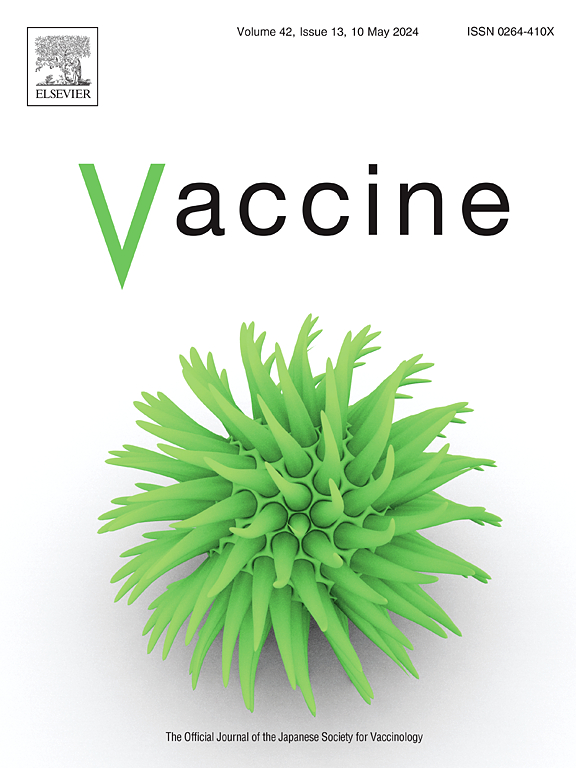一种新的体外96孔测定法,用于评估无细胞百日咳联合疫苗最终产物中的百日咳毒素活性
IF 4.5
3区 医学
Q2 IMMUNOLOGY
引用次数: 0
摘要
百日咳博德泰拉产生百日咳毒素(PT)作为主要的毒力因子;脱毒的PT是无细胞百日咳疫苗的必要抗原。利用小鼠组胺致敏试验(HIST)对百日咳疫苗中PT(残余毒性和毒性逆转)的毒性进行了长期评估。在这项研究中,作为基于动物安全性测试的HIST的替代方案,我们开发了96孔体外实验(胎儿素- adp -核糖基化实验),该实验评估了S1亚基的adp -核糖基转移酶和PT中b -寡聚物的碳水化合物结合活性,并评估了其对无细胞百日咳联合疫苗(百白破、百白破- ipv和百白破- ipv - hib)最终产品的适用性。胎蛋白- adpr检测基于两步过程:(i)使用胎蛋白包被磁珠从疫苗样品中回收保留糖结合活性的PT抗原,(ii)使用用靶分子Gαi3C20肽固定的96孔微孔板测量回收的PT抗原的adp -核糖基转移酶活性。在检测系统中,PT参比物NIBSC 90/518的标准曲线在320 ng/mL处呈线性响应(R2≥0.98)。胎儿素- adpr试验显示,在大多数4℃保存的最终疫苗产品中,可激活的PT含量为20 ng/mL(低于检测限),而在37℃保存28天的疫苗中,可激活的PT含量为20 ~ 159.7 ng/mL。该试验成功地检测了解毒PT的毒性逆转。胎儿素- adpr试验的验证表明,根据峰值回收率评估,该试验的日常重复性为27.5%的变异系数和44 - 50%的准确性。胎儿素- adpr测定的优点是可以在96孔板和标准实验室设备中进行,是一种有希望的替代体内HIST的方法,用于评估无细胞百日咳联合疫苗最终产物中的PT毒性。本文章由计算机程序翻译,如有差异,请以英文原文为准。
A novel 96-well in vitro assay for assessing pertussis toxin activity in the final products of acellular pertussis combination vaccines
Bordetella pertussis produces pertussis toxin (PT) as a major virulence factor; detoxified PT is an essential antigen for acellular pertussis vaccines. The toxicity of PT (residual toxicity and reversion to toxicity) in pertussis vaccines has long been assessed using the mouse histamine sensitization test (HIST). In this study, as an alternative to animal safety testing-based HIST, a 96-well in vitro assay (fetuin-ADP-ribosylation assay), which assesses both the ADP-ribosyltransferase of the S1 subunit and the carbohydrate-binding activities of the B-oligomer in PT, was developed and evaluated for its applicability to the final products of acellular pertussis combination vaccines, DPT, DPT-IPV, and DPT-IPV-Hib. The fetuin-ADPR assay is based on a two-step process: (i) recovery of PT antigen with retained carbohydrate-binding activity from vaccine samples using fetuin-coated magnetic beads, and (ii) measurement of ADP-ribosyltransferase activity of the recovered PT antigen using a 96-well microplate immobilized with the target molecule, Gαi3C20 peptide. In the assay system, the standard curve of the PT reference NIBSC 90/518 exhibited a linear response up to 320 ng/mL (R2 ≥ 0.98). The fetuin-ADPR assay showed that the activatable PT content in most final vaccine products stored at 4 °C was <20 ng/mL (below the detection limit), whereas that in vaccines stored at 37 °C for 28 days ranged from <20 to 159.7 ng/mL. The assay successfully detected the reversion to toxicity of detoxified PT. Validation of the fetuin-ADPR assay showed a day-to-day reproducibility of 27.5 % coefficient of variation and 44–50 % accuracy as assessed by spike recovery. The fetuin-ADPR assay has the advantage of being performed in a 96-well plate with standard laboratory equipment, and is a promising alternative to in vivo HIST for assessing PT toxicity in the final products of acellular pertussis combination vaccines.
求助全文
通过发布文献求助,成功后即可免费获取论文全文。
去求助
来源期刊

Vaccine
医学-免疫学
CiteScore
8.70
自引率
5.50%
发文量
992
审稿时长
131 days
期刊介绍:
Vaccine is unique in publishing the highest quality science across all disciplines relevant to the field of vaccinology - all original article submissions across basic and clinical research, vaccine manufacturing, history, public policy, behavioral science and ethics, social sciences, safety, and many other related areas are welcomed. The submission categories as given in the Guide for Authors indicate where we receive the most papers. Papers outside these major areas are also welcome and authors are encouraged to contact us with specific questions.
 求助内容:
求助内容: 应助结果提醒方式:
应助结果提醒方式:


